If California dumps the death penalty this November, abolitionists will probably dance in the streets. But they shouldn’t, because the state would be abandoning one terrible idea only to replace it with another.
The so-called Savings, Accountability, and Full Enforcement for California Act, or SAFE, would eliminate capital punishment across the board in favor of life without parole. Death-penalty opponents easily collected more than half a million signatures to get SAFE on the ballot. If it passes, the lives of 725 prisoners currently awaiting execution will be spared. Instead of dying on a gurney from lethal injection, they will die in prison of natural causes (or maybe violence).
The impetus behind SAFE is largely economic. California has spent more than $4 billion on capital punishment since 1976, and executed 13 people. And since well over half the costs of a death-penalty case occur before the appeals even begin, there is no way to lower those costs meaningfully, short of adopting a legal system modeled on that of Iran or the DR Congo. So fiscal hawks in California, even law-and-order fiscal hawks, appear ready to write off the death-penalty experiment as a failure.
But cost isn’t the only factor. Opponents of the death penalty have passionately embraced LWOP—as the alternative sentence is affectionately known—because it undeniably saves lives. In 2005, Texas, which executes far more people than any other state, gave juries the option of imposing LWOP instead of execution. The number of death sentences plummeted, from 30 to 40 a year down to the single digits today.

LWOP also appeals, of course, to voters who are worried about executing an innocent person. The remarkable spate of DNA exonerations over the past two decades has permeated the public consciousness. People who never thought about the criminal justice system before, or who figured it was reliable, have heard story after story of men sent to prison or death row for years, sometimes decades, only to be found innocent. These same people sit on juries, and they don’t want the next mistake to be theirs. Since most death-penalty cases don’t have DNA evidence proving the accused’s guilt, many jurors are left with a nagging doubt. For them, LWOP is perfect: They can convict someone they’re pretty sure is a murderer and know he’ll be forever removed from society, but if he turns out to be innocent, he’ll still be around (we hope) to reclaim what is left of his life.
Regardless of why they prefer LWOP, if voters approve SAFE, California will become the sixth state in five years to abandon the death penalty. But with a death-row population about thirty times the size of those of the other five states combined, California’s decision would dwarf the others in significance.
Nevertheless, death-penalty opponents should not be too quick to celebrate. Life without parole is as dehumanizing as death itself, and in some ways it is even worse.
On the plus side, LWOP saves lives, but that’s about it. In every other way it’s a nightmare: It gives up on everyone, regardless of whether they exhibit any capacity for growth and change; it robs people of hope; it exaggerates the risk to society of releasing convicted murderers; and it turns prisons into geriatric wards, with inmates rolling around in taxpayer-funded wheelchairs carrying oxygen canisters in their laps.
To the extent there is a coherent rationale underlying LWOP, it rests on two mistaken premises. First, many people think we need to lock up murderers forever to keep society safe. But it is a myth that murderers kill over and over again, and we have the data to prove it.
In 1972, when the Supreme Court struck down capital punishment nationwide, 589 people were on death row. Of those, 322 were ultimately released, and 111 of them eventually returned to prison. How many of those 111 do you think went back for murder?
Three.
Obviously, that’s still three deaths that would’ve been avoided had those men been executed or not paroled. Also, just because most people who have killed once do not kill again—that two-thirds of them never even return to prison—doesn’t prove that everyone who commits murder should be released.
But that’s the problem with LWOP: It doesn’t even allow consideration of whether someone has earned his or her release.
This brings us to the second premise, which is that sometimes we want to punish people simply for the sake of punishing them, to express society’s outrage at the commission of abhorrent acts. There are indeed good reasons for a society to punish people who do bad things. But is this really the message we want to send as a society? That one horrible act will render you permanently unredeemable, no matter what you do or how you may change over the rest of your life?
It’s an undeniable fact that even people who do terrible things can change. A kid who commits murder when he’s twenty can be a substantially different person when he’s fifty, much less sixty. Maybe it feels good on some level to tell that twenty-year-old he will never see the light of day again. But in the end, this narrow, angry, stubborn posture hurts us as a culture far more than it could ever hurt the kid.
Obviously there are some degenerates who will never change. It’s been more than forty years since the Tate-LaBianca murders in Los Angeles, and I still wouldn’t want Charles Manson living in my neighborhood. Other crimes are so notorious—the Oklahoma City bombing, for example—that society might just not be interested in whether the murderers have reformed.
Most people who have killed, however, are neither so infamous nor so depraved. They are people who did something horrible. Maybe some of them did something so appalling we can never again abide allowing them to live in our midst. But some of them truly repent and change. Some actually receive forgiveness from their victims’ survivors. I had a client years ago who met the mother of the young man he killed, and she pleaded with the parole board to spare his life. (They rebuffed her.)
Also, of course, prisoners who are eligible for parole are not guaranteed release. That decision is made by parole board members, who take into consideration what the inmate did as well as who he has become. Certainly they make mistakes, but is that a reason for a blanket rule that everyone who murders should be prevented from even making a case for their release? For every Willie Horton, there are hundreds, probably thousands, of paroled inmates who spend the rest of their lives respecting the law.
Most prisoners sentenced to life will never get out of prison anyway, because wary parole boards will be scared to release them (see, for example, Mr. Manson). But LWOP’s core defect is that is prevents even reformed murderers from asking. A society that embraces LWOP is a society that has thrown in the towel way too early.






